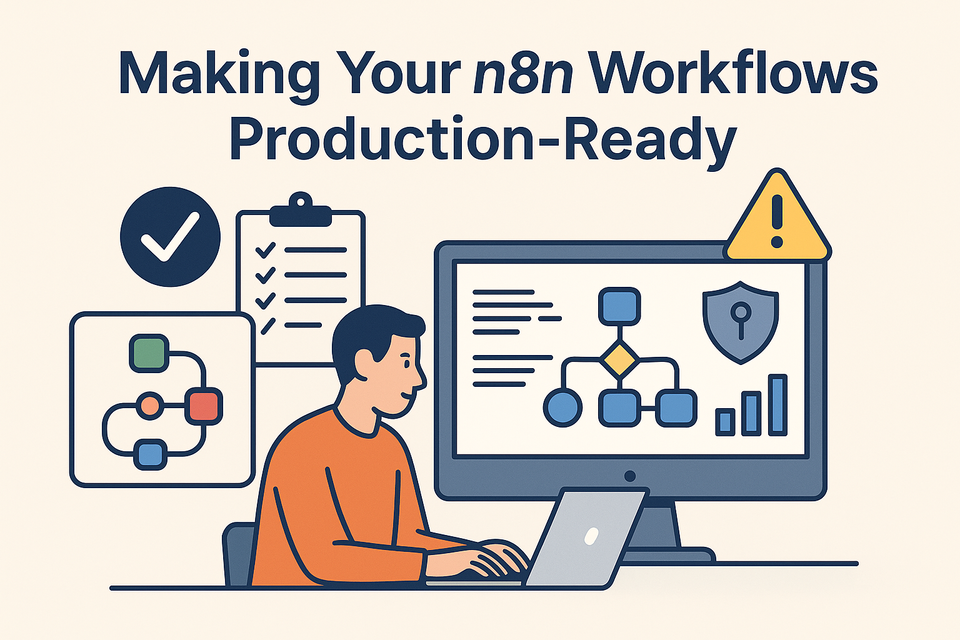Making Your n8n Workflows Production-Ready 🚀

Just like regular software, production-ready workflows should be secure, maintainable, and resilient.
Here’s a checklist of what to keep in mind before putting your n8n workflow into production — and a few practical ways to get there.
🪵 1. Logging & Monitoring
Once a workflow is running in production, you want to know what it’s doing — and when something goes wrong.
- Add logging steps (e.g., append to Airtable, Notion, or even Google Sheets).
- Send key events or errors to Slack, Discord, or Telegram.
- Use the Error Trigger node to catch and respond to unexpected failures.
💡 Tip: Create a central “log collector” workflow and call it with a Webhook or HTTP Request from others.
⚠️ 2. Error Handling & Notifications
Things will fail. APIs time out, data is missing, tokens expire.
- Use
IFnodes after external requests to check status codes or response bodies. - Wrap risky parts of the flow with
Try/Catchlogic (like splitting with IF nodes and routing errors to a fallback). - Notify yourself (or your team) immediately when something breaks.
Don't wait for your client or end user to discover something’s wrong.
🔐 3. Secure Your Credentials
This one’s big. Never, ever store API keys or passwords in Set nodes or environment variables manually.
- Always use the Credential Manager in n8n.
- Review credentials regularly, especially if people leave your team or rotate access tokens.
- Limit permissions — don’t give full access to an API if read-only will do.
Security in no-code tools is still real security. Take it seriously.
⚡ 4. Optimize for Performance
Especially when working with databases or large datasets:
- Don’t use
SELECT *. Only query the fields you need. - Use
WHERE,LIMIT, andORDER BYto narrow results. - Break loops into batches if you're processing hundreds or thousands of rows.
- Use pagination where possible (many APIs support it!).
Poorly optimized workflows can run slowly — or fail altogether.
🧩 5. Keep Workflows Clean and Modular
Big, messy workflows are hard to debug and even harder to maintain.
- Use clear names for every node.
- Color-code and group related steps.
- Split large workflows into smaller ones using
Execute Workflow.
You'll thank yourself (or your teammates will) the next time you need to make a change.
🔁 6. Set Up Scheduled Maintenance
- Use
Cronnodes to schedule cleanup or routine checks. - Archive old data.
- Send regular summary reports to yourself or clients.
Think of this like writing a mini DevOps plan for your automations.
🛠️ 7. Version Control and Backups
There’s no undo button after a bad edit.
- Use the built-in n8n backup/export features before major changes.
- Consider versioning with Git if you’re using n8n’s CLI or self-hosted version.
- Add a description to each workflow explaining what it does and why it exists.
🧪 8. Test Before You Launch
- Clone workflows and test with dummy data.
- Use test-specific triggers or add feature flags for sensitive flows.
- If possible, have a staging environment where you can safely test changes.
No one likes surprises in production.
🔍 9. Handle Data Responsibly
- Avoid storing unnecessary PII.
- If you must store sensitive data, encrypt it or redact logs.
- Clear out temporary variables once you’re done with them.
Respect your users and your data privacy obligations.
✅ Wrapping Up
Just because you’re using a no-code tool doesn’t mean you should skip what makes real software good software.
- Handle errors.
- Secure data.
- Monitor what’s going on.
- Keep things clean and maintainable.
The beauty of n8n is how powerful it is — and with a little care, your workflows can be just as reliable as any custom-coded system.